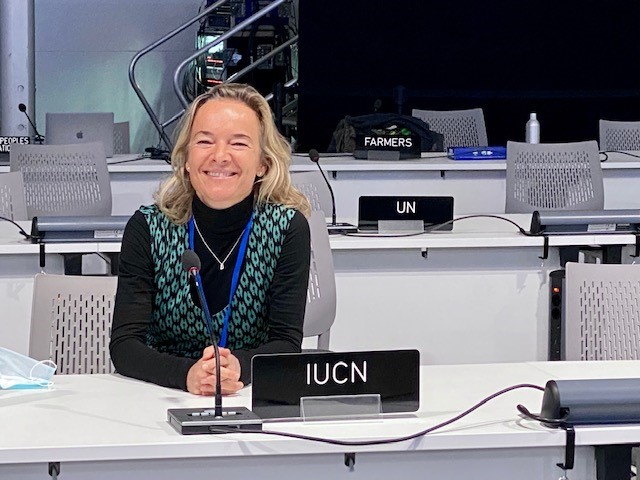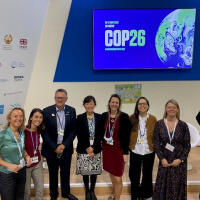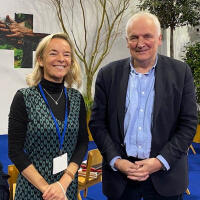Twelve days in Glasgow: Impressions of a first time Climate COP experience
Blog by Claire Warmenbol. Exactly one month ago the COP26 hammer was gaveled. These are my impressions from that climate conference - my first - which I found it to be like no other, both in terms of diversity and calibre of participants as well as in vigour and variety of content.

Photo: ©IUCN/Sandeep Sengupta
Perhaps it was the pandemic that made it all the more intense, I do not know, but ‘overwhelming’ and ‘full-on’ were frequent words to describe what was going on. It is impossible to capture it all, so I will stick to a top 5 of impressions and outcomes.
First and foremost that must be the sheer number of people who managed to make it to Glasgow. Over 40,000 people attended from all corners of the world. Considering a large majority of the world population wasn’t moving much beyond the local grocery store just a few months ago, this was in itself an amazing feat, both on the part of the UNFCCC organisers as well as from the sheer determination of the travelling participants themselves.
Second, the calibre and diversity of people you meet or simply walk past in the corridors is – again, to me, as a novice - astonishing. Presidents, Ministers, Spiritual Leaders, Indigenous Chiefs, beacons such as John Kerry, Bill Gates, Jeff Bezos, Emmanuel Macron, Leonardo DiCaprio, and so forth are there just like anyone else (okay maybe Leo a little less casually). A bit as if the Oscars, the Nobel Prize, the World Economic Forum converged with Pachamama without an award ceremony. The feeling you get is that you are at the epicentre of power and fame, of influence and knowledge.
Third, the young women taking centre stage. I must say I am in awe of all of the young people, and in particular the dedicated, incredibly well-versed and confident young women I have seen taking to the stage and speaking with a vigour and determination worthy of standing ovations (which they did get). Too many times we still spotted the out-dated “manels” (panels with only men) and listening to just 50% isn’t going to get us out of this crisis. In witnessing the rise of these young women, I trust it is only a matter of time that this will change. Keep an eye on Elizabeth Wathuti, Vanessa Nakate, Clover Hogan, and many more.
 Photo: ©IUCN/Claire Warmenbol
Photo: ©IUCN/Claire Warmenbol
And fifth, the mind-boggling number of events taking place at the same time. For a serious sufferer of FOMO (a person with ‘Fear Of Missing Out’) this was ground zero. Plenaries, climate action sessions, pavilion events (over 50 large pavilions held their own busy schedules of events), press conferences, UK presidency sessions, and not to forget, all the negotiations happening behind closed doors. And that was within the Blue Zone. A whole other array of events went on all around Glasgow, such as the Green Zone, the Extreme Hangout, the New York Times Climate Hub, Concerts for Climate and so forth.
I simply had to come to peace with…well, missing out on a lot. Going to Glasgow my role was four-fold, or as we say on-trend today, “hybrid”. I was a hybrid staff member across the Global Water Programme, the Nature-based Solutions Group, the Global Communications Unit and the IUCN European Office.
 Photo: ©Water Pavilion COP26
Photo: ©Water Pavilion COP26
As climate is to a large extend a water problem - through too much or too little water - the knowledge the water pavilion brought to COP was more than needed. How to deal with increased flooding? How to prepare for frequent drought? How to keep feeding the world’s growing population? How to avoid water wars? Answers – and more importantly – solutions to these challenges exist, and the water community brought them to COP. It was an honour to be a part of this ‘first’, and my guess, not last water collaboration: COP26 Water Pavilion.
IUCN highlighted the critical role restored and sustainably managed ecosystems can play in the fight against climate change through Nature-based Solutions (NbS). The IUCN Position Paper, inspired by the Marseille Manifesto, was a key document and reference point in meetings and negotiations. Our colleague Chris Buss, seconded as part of the COP26 High-Level Champions team, brought IUCN to the heart of the UK Presidency programme. Previously through that engagement, Nigel Topping, the UK High-Level Champion had moderated the closing plenary on climate change at our IUCN Congress which I had had the chance to help deliver.
With the IUCN communications colleagues, the Regen10 report was launched, an ambitious action plan to scale regenerative food production systems worldwide, putting farmers at the heart of the transformation. A joint IUCN-UNEP report revealed how NbS, in addition to rapid decarbonisation, can make a significant contribution in keeping global warming below 1.5°C (see report). The German Environment Ministry announced the provision of an additional €10m to the Global EbA Fund. The Great Blue Wall was launched, an initiative aiming to protect 30% of the Western Indian Ocean by 2030. It was a busy time for communications! Further reports launched by IUCN included new analysis from CDP and IUCN on corporate disclosures, the global progress on gender inclusion in Nationally Determined Contributions, the launch of the International Steering Committee for the NbS standard, and much more, see IUCN at COP26.
As COP26 headed into week 2, there was a change in gear and shift. Some colleagues returned home whilst others (new and fresh) arrived. This was welcome. COPs are gruelling, early mornings into late evenings, all-consuming work and that for two weeks, in a cold (but not rainy!) November Glasgow. But they are strangely energising too. There is a buzz, an energy, and perhaps the post-lockdown high of being amongst many (masked) people again. A haven for extroverts, purgatory for introverts. On the topic of masks and many people, each day before accessing the venue, all delegates had to do a Covid lateral flow test and at the time of writing, just 291 covid cases linked to Cop26 were recorded.
 Photo: ©IUCN/Sandeep Sengupta
Photo: ©IUCN/Sandeep Sengupta
As I settled in back home and followed the latest on COP26 leading to the Glasgow Climate Pact and IUCN’s closing statement, I adjusted the clocks (some still on UK time, some still on summer time) and remembered David Attenborough’s speech at the COP Opening “In my lifetime, I’ve witnessed a terrible decline. In yours, you could and should witness a wonderful recovery” (link). We should indeed!
My over-arching (or aching) feeling was that of being tired but inspired, neither pessimistic nor optimistic, but enthusiastic in my commitment to keep pushing for a nature positive world. In watching The Lorax with my son on my first evening back - and being very aware that his generation will be carrying the consequences of our (in)actions - I will end my blog with the poem of Dr Seuss: “Unless someone like you, cares a whole awful lot, nothing is going to get better. It’s not”. And many people do care a whole awful lot, that is by far my key take-home feeling.
A short word of thanks:
Thank you to my boss James Dalton, who let me fly my wings during this conference and this is how I work best; gratitude to the many colleagues from IUCN who worked behind the scenes or remotely and were crucial in making IUCN’s participation a success; thank you to my family and friends who kept me going and sent me encouraging messages; thank you to my Airbnb adopted Glaswegian parents Scott and Julia for hosting me and giving me some idea of Scottish culture (and whiskey), and my second Airbnb hosts Ashwini and Tom from GGON; and finally thank you to the father of my son, for keeping the home-front going.
***
This story was originally posted in the IUCN internal newsletter CONNECT on 24 November 2021.
